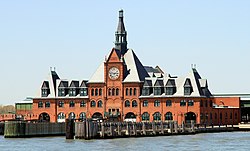Central Railroad of New Jersey
 |
|

|
|
| Reporting mark | CNJ |
|---|---|
| Locale |
New Jersey Pennsylvania |
| Dates of operation | 1839–1976 |
| Successor | Conrail |
| Track gauge | 4 ft 8 1⁄2 in (1,435 mm) standard gauge |
| Length | 693 miles (1,115 kilometers) |
| Headquarters | 148 Liberty Street New York, New York |
The Central Railroad of New Jersey, also known as the Jersey Central or Jersey Central Lines (reporting mark CNJ), was a Class I railroad with origins in the 1830s. It filed for bankruptcy three times; in 1939, 1947 and on 3/22/1967 the CNJ filed for bankruptcy for the final time. It foreshadowed the rest of New Jersey's railroads, but not by much. It then pulled out of Pennsylvania completely in 1972. While most of the passenger services, structures and equipment were picked up by the State of New Jersey, later NJ TRANSIT, it was absorbed into Conrail in April 1976 along with several other prominent bankrupt railroads of the northeastern United States.
The Central Railroad of New Jersey's main line had a major presence in New Jersey, most of the CNJ's main line is now used by the Raritan Valley Line passenger service and trackage from the CNJ main line in Phillipsburg, New Jersey became part of the Lehigh Line under Conrail; the Lehigh Line is officially the former main line of the Lehigh Valley Railroad.
The Elizabethtown and Somerville Railroad was chartered on February 9, 1831, to build from Elizabeth on the Newark Bay (with a steamboat transfer to New York City) west to Somerville. The line to Plainfield was completed in March 1839, connecting to the New Jersey Rail Road in Elizabeth. Extensions took it west to Dunellen in 1840, just east of Bound Brook in 1841 and to Somerville in 1842.
...
Wikipedia
